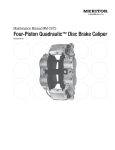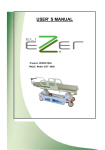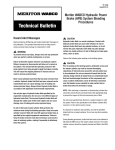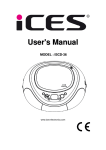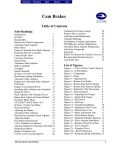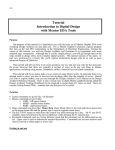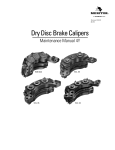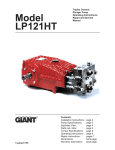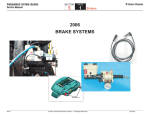Download Maintenance Manual MM-2075
Transcript
Issued 01-01 $2.50 Four-Piston Quadraulic Disc Brake Caliper TM Maintenance Manual MM-2075 Service Notes Before You Begin Service Notes This manual provides maintenance and service procedures for Meritor’s four-piston quadraulic disc brake calipers. Before you begin procedures: 1. Read and understand all instructions and procedures before you begin to service components. 2. Read and observe all Caution and Warning safety alerts that precede instructions or procedures you will perform. These alerts help to avoid damage to components, serious personal injury, or both. 3. Follow your company’s maintenance and service, installation, and diagnostics guidelines. 4. Use special tools when required to help avoid serious personal injury and damage to components. Safety Alerts, Torque Symbol and Notes A Warning alerts you to an WARNING instruction or procedure that you must follow exactly to avoid serious personal injury and damage to components. CAUTION A Caution alerts you to an instruction or procedure that you must follow exactly to avoid damage to components and possible serious injury. A torque symbol alerts you to tighten fasteners to a specified torque value. NOTE 1 A Note provides information or suggestions that help you correctly service a component. Access Information on ArvinMeritor’s Web Site Additional maintenance and service information for ArvinMeritor’s commercial vehicle systems component lineup is also available at www.arvinmeritor.com. To access information, click on Products & Services/Tech Library Icon/HVS Publications. The screen will display an index of publications by type. Additional Information Call ArvinMeritor’s Customer Service Center at 800-535-5560 to order the following item. O Drivetrain PlusTM by ArvinMeritor Technical Electronic Library on CD. Features product and service information on most Meritor, ZF Meritor and Meritor WABCO products. $20. Order TP-9853. Table of Contents Asbestos and Non-Asbestos Fibers Warnings . . . . . . . . . . . . . . . . . . . . . . . . . . . . . . . . . . . . . . .1 Section 1: Exploded Views . . . . . . . . . . . . . . . . . . . . . . . . . . . . . . . . . . . . . . . . . . . . . . . . . . . . . . . . . . . . .2 Section 2: Introduction Product Features . . . . . . . . . . . . . . . . . . . . . . . . . . . . . . . . . . . . . . . . . . . . . . . . . . . . . . . . . . . . . . . . . . . . . .3 Four-Piston Quadraulic Disc Brake Caliper Caliper Support Hub/Rotor . . . . . . . . . . . . . . . . . . . . . . . . . . . . . . . . . . . . . . . . . . . . . . . . . . . . . . . . . . . . . . . . . . . . . . . . . . . .4 Section 3: Disassembly Removal . . . . . . . . . . . . . . . . . . . . . . . . . . . . . . . . . . . . . . . . . . . . . . . . . . . . . . . . . . . . . . . . . . . . . . . . . . . . .5 Brake Pads Replace Brake Pads Brake Caliper . . . . . . . . . . . . . . . . . . . . . . . . . . . . . . . . . . . . . . . . . . . . . . . . . . . . . . . . . . . . . . . . . . . . . . . . .6 Support . . . . . . . . . . . . . . . . . . . . . . . . . . . . . . . . . . . . . . . . . . . . . . . . . . . . . . . . . . . . . . . . . . . . . . . . . . . . . .7 Rotor Disassemble and Overhaul the Brake Caliper Section 4: Prepare Parts for Assembly Clean, Dry and Inspect Parts . . . . . . . . . . . . . . . . . . . . . . . . . . . . . . . . . . . . . . . . . . . . . . . . . . . . . . . . . . . .10 Clean Parts Dry and Inspect Parts Apply Corrosion Protection Section 5: Assembly and Installation Assembly . . . . . . . . . . . . . . . . . . . . . . . . . . . . . . . . . . . . . . . . . . . . . . . . . . . . . . . . . . . . . . . . . . . . . . . . . . .11 Brake Caliper Installation . . . . . . . . . . . . . . . . . . . . . . . . . . . . . . . . . . . . . . . . . . . . . . . . . . . . . . . . . . . . . . . . . . . . . . . . . .12 Rotor Caliper Brake Pads . . . . . . . . . . . . . . . . . . . . . . . . . . . . . . . . . . . . . . . . . . . . . . . . . . . . . . . . . . . . . . . . . . . . . . . . . .13 Assemble the Support . . . . . . . . . . . . . . . . . . . . . . . . . . . . . . . . . . . . . . . . . . . . . . . . . . . . . . . . . . . . . . . . .14 Section 6: Inspection Inspect Parts . . . . . . . . . . . . . . . . . . . . . . . . . . . . . . . . . . . . . . . . . . . . . . . . . . . . . . . . . . . . . . . . . . . . . . . . .15 Caliper Caliper Mounting Plate Brake System Bleeding Procedure Section 7: Troubleshooting Brakes . . . . . . . . . . . . . . . . . . . . . . . . . . . . . . . . . . . . . . . . . . . . . . . . . . . . . . . . . . . . . . . . . . . . . . . . . . . . . .16 Section 8: Torque Specifications . . . . . . . . . . . . . . . . . . . . . . . . . . . . . . . . . . . . . . . . . . . . . . . . . . . . . .18 Asbestos and Non-Asbestos Fibers ASBESTOS FIBERS WARNING The following procedures for servicing brakes are recommended to reduce exposure to asbestos fiber dust, a cancer and lung disease hazard. Material Safety Data Sheets are available from ArvinMeritor. NON-ASBESTOS FIBERS WARNING The following procedures for servicing brakes are recommended to reduce exposure to non-asbestos fiber dust, a cancer and lung disease hazard. Material Safety Data Sheets are available from ArvinMeritor. Hazard Summary Hazard Summary Because some brake linings contain asbestos, workers who service brakes must understand the potential hazards of asbestos and precautions for reducing risks. Exposure to airborne asbestos dust can cause serious and possibly fatal diseases, including asbestosis (a chronic lung disease) and cancer, principally lung cancer and mesothelioma (a cancer of the lining of the chest or abdominal cavities). Some studies show that the risk of lung cancer among persons who smoke and who are exposed to asbestos is much greater than the risk for non-smokers. Symptoms of these diseases may not become apparent for 15, 20 or more years after the first exposure to asbestos. Accordingly, workers must use caution to avoid creating and breathing dust when servicing brakes. Specific recommended work practices for reducing exposure to asbestos dust follow. Consult your employer for more details. Most recently manufactured brake linings do not contain asbestos fibers. These brake linings may contain one or more of a variety of ingredients, including glass fibers, mineral wool, aramid fibers, ceramic fibers and silica that can present health risks if inhaled. Scientists disagree on the extent of the risks from exposure to these substances. Nonetheless, exposure to silica dust can cause silicosis, a non-cancerous lung disease. Silicosis gradually reduces lung capacity and efficiency and can result in serious breathing difficulty. Some scientists believe other types of non-asbestos fibers, when inhaled, can cause similar diseases of the lung. In addition, silica dust and ceramic fiber dust are known to the State of California to cause lung cancer. U.S. and international agencies have also determined that dust from mineral wool, ceramic fibers and silica are potential causes of cancer. Accordingly, workers must use caution to avoid creating and breathing dust when servicing brakes. Specific recommended work practices for reducing exposure to non-asbestos dust follow. Consult your employer for more details. Recommended Work Practices 1. Separate Work Areas. Whenever feasible, service brakes in a separate area away from other operations to reduce risks to unprotected persons. OSHA has set a maximum allowable level of exposure for asbestos of 0.1 f/cc as an 8-hour time-weighted average and 1.0 f/cc averaged over a 30-minute period. Scientists disagree, however, to what extent adherence to the maximum allowable exposure levels will eliminate the risk of disease that can result from inhaling asbestos dust. OSHA requires that the following sign be posted at the entrance to areas where exposures exceed either of the maximum allowable levels: DANGER: ASBESTOS CANCER AND LUNG DISEASE HAZARD AUTHORIZED PERSONNEL ONLY RESPIRATORS AND PROTECTIVE CLOTHING ARE REQUIRED IN THIS AREA. 2. Respiratory Protection. Wear a respirator equipped with a high-efficiency (HEPA) filter approved by NIOSH or MSHA for use with asbestos at all times when servicing brakes, beginning with the removal of the wheels. 3. Procedures for Servicing Brakes. a. Enclose the brake assembly within a negative pressure enclosure. The enclosure should be equipped with a HEPA vacuum and worker arm sleeves. With the enclosure in place, use the HEPA vacuum to loosen and vacuum residue from the brake parts. b. As an alternative procedure, use a catch basin with water and a biodegradable, non-phosphate, water-based detergent to wash the brake drum or rotor and other brake parts. The solution should be applied with low pressure to prevent dust from becoming airborne. Allow the solution to flow between the brake drum and the brake support or the brake rotor and caliper. The wheel hub and brake assembly components should be thoroughly wetted to suppress dust before the brake shoes or brake pads are removed. Wipe the brake parts clean with a cloth. c. If an enclosed vacuum system or brake washing equipment is not available, employers may adopt their own written procedures for servicing brakes, provided that the exposure levels associated with the employer’s procedures do not exceed the levels associated with the enclosed vacuum system or brake washing equipment. Consult OSHA regulations for more details. d. Wear a respirator equipped with a HEPA filter approved by NIOSH or MSHA for use with asbestos when grinding or machining brake linings. In addition, do such work in an area with a local exhaust ventilation system equipped with a HEPA filter. e. NEVER use compressed air by itself, dry brushing, or a vacuum not equipped with a HEPA filter when cleaning brake parts or assemblies. NEVER use carcinogenic solvents, flammable solvents, or solvents that can damage brake components as wetting agents. 4. Cleaning Work Areas. Clean work areas with a vacuum equipped with a HEPA filter or by wet wiping. NEVER use compressed air or dry sweeping to clean work areas. When you empty vacuum cleaners and handle used rags, wear a respirator equipped with a HEPA filter approved by NIOSH or MSHA for use with asbestos. When you replace a HEPA filter, wet the filter with a fine mist of water and dispose of the used filter with care. 5. Worker Clean-Up. After servicing brakes, wash your hands before you eat, drink or smoke. Shower after work. Do not wear work clothes home. Use a vacuum equipped with a HEPA filter to vacuum work clothes after they are worn. Launder them separately. Do not shake or use compressed air to remove dust from work clothes. 6. Waste Disposal. Dispose of discarded linings, used rags, cloths and HEPA filters with care, such as in sealed plastic bags. Consult applicable EPA, state and local regulations on waste disposal. Regulatory Guidance References to OSHA, NIOSH, MSHA, and EPA, which are regulatory agencies in the United States, are made to provide further guidance to employers and workers employed within the United States. Employers and workers employed outside of the United States should consult the regulations that apply to them for further guidance. Recommended Work Practices 1. Separate Work Areas. Whenever feasible, service brakes in a separate area away from other operations to reduce risks to unprotected persons. 2. Respiratory Protection. OSHA has set a maximum allowable level of exposure for silica of 0.1 mg/m3 as an 8-hour time-weighted average. Some manufacturers of nonasbestos brake linings recommend that exposures to other ingredients found in nonasbestos brake linings be kept below 1.0 f/cc as an 8-hour time-weighted average. Scientists disagree, however, to what extent adherence to these maximum allowable exposure levels will eliminate the risk of disease that can result from inhaling nonasbestos dust. Therefore, wear respiratory protection at all times during brake servicing, beginning with the removal of the wheels. Wear a respirator equipped with a high-efficiency (HEPA) filter approved by NIOSH or MSHA, if the exposure levels may exceed OSHA or manufacturers’ recommended maximum levels. Even when exposures are expected to be within the maximum allowable levels, wearing such a respirator at all times during brake servicing will help minimize exposure. 3. Procedures for Servicing Brakes. a. Enclose the brake assembly within a negative pressure enclosure. The enclosure should be equipped with a HEPA vacuum and worker arm sleeves. With the enclosure in place, use the HEPA vacuum to loosen and vacuum residue from the brake parts. b. As an alternative procedure, use a catch basin with water and a biodegradable, non-phosphate, water-based detergent to wash the brake drum or rotor and other brake parts. The solution should be applied with low pressure to prevent dust from becoming airborne. Allow the solution to flow between the brake drum and the brake support or the brake rotor and caliper. The wheel hub and brake assembly components should be thoroughly wetted to suppress dust before the brake shoes or brake pads are removed. Wipe the brake parts clean with a cloth. c. If an enclosed vacuum system or brake washing equipment is not available, carefully clean the brake parts in the open air. Wet the parts with a solution applied with a pump-spray bottle that creates a fine mist. Use a solution containing water, and, if available, a biodegradable, non-phosphate, water-based detergent. The wheel hub and brake assembly components should be thoroughly wetted to suppress dust before the brake shoes or brake pads are removed. Wipe the brake parts clean with a cloth. d. Wear a respirator equipped with a HEPA filter approved by NIOSH or MSHA when grinding or machining brake linings. In addition, do such work in an area with a local exhaust ventilation system equipped with a HEPA filter. e. NEVER use compressed air by itself, dry brushing, or a vacuum not equipped with a HEPA filter when cleaning brake parts or assemblies. NEVER use carcinogenic solvents, flammable solvents, or solvents that can damage brake components as wetting agents. 4. Cleaning Work Areas. Clean work areas with a vacuum equipped with a HEPA filter or by wet wiping. NEVER use compressed air or dry sweeping to clean work areas. When you empty vacuum cleaners and handle used rags, wear a respirator equipped with a HEPA filter approved by NIOSH or MSHA, to minimize exposure. When you replace a HEPA filter, wet the filter with a fine mist of water and dispose of the used filter with care. 5. Worker Clean-Up. After servicing brakes, wash your hands before you eat, drink or smoke. Shower after work. Do not wear work clothes home. Use a vacuum equipped with a HEPA filter to vacuum work clothes after they are worn. Launder them separately. Do not shake or use compressed air to remove dust from work clothes. 6. Waste Disposal. Dispose of discarded linings, used rags, cloths and HEPA filters with care, such as in sealed plastic bags. Consult applicable EPA, state and local regulations on waste disposal. Regulatory Guidance References to OSHA, NIOSH, MSHA, and EPA, which are regulatory agencies in the United States, are made to provide further guidance to employers and workers employed within the United States. Employers and workers employed outside of the United States should consult the regulations that apply to them for further guidance. 1 Section 1 Exploded Views Section 1 Views Exploded Previous Style SPRING HEX BOLT LINING ASSEMBLY PISTON BUTTON HEAD BOLT PISTON SEAL SPACER LINING HEAT SHIELD DUST BOOT DUST BOOT HEAT SHIELD PISTON SEAL PISTON CALIPER HOUSING Current Style SPRING HEX BOLT LINING ASSEMBLY PISTON BUTTON HEAD BOLT PISTON SEAL SPACER LINING DUST BOOT DUST BOOT PISTON CALIPER HOUSING 2 PISTON SEAL Section 2 Introduction Product Features Section 2 Introduction Four-Piston Quadraulic Disc Brake Caliper Meritor’s quadraulic disc brakes have a four-piston, fixed-mount caliper design for use on both front and rear drive axles. An installation includes four major components — the caliper assembly, support assembly, hub/rotor assembly and the attaching hardware. The inboard pistons apply the inboard pads and the outboard pistons apply the outboard pads. Two sizes of calipers are used, 2.520-inch (64 mm) and 2.756-inch (70 mm). Features of the caliper include: O Designed for hydraulic brake systems. O Hard-mounted to the anchor plate to eliminate caliper and anchor plate replacement. O Designed with hardened stainless steel mounting surfaces, high temperature piston boot compound, sealed bleeder screws and full-coverage zinc plating. O Compatible with anti-lock braking systems (ABS) and existing hydraulic systems. Current Style Previous Style Metric caliper bolts SAE caliper bolts Caliper housing halves held together by bolts in blind holes in the bridge area. Caliper housing halves held together by bolts and nuts in the bridge area. Integral piston/heat shield Separate piston and heat shield Phenolic piston Metal piston Caliper O The caliper assembly consists of two halves assembled with four bolts and washers. O It includes four hydraulic piston bores, two brake pads, two stainless steel lining rail covers installed with button head bolts, a pad retainer spring and bolt, bleeder screw and crossover tube. O The piston bores contain the pistons, piston seals and piston boots. O The crossover tubes connect the two halves of the caliper piston to supply brake fluid to the outboard pistons. O Helps to increase lining life. How to Identify the Caliper O Can be adapted to fit most vehicles with a hydraulic system that supplies to 1,800 psi (12,402 kPa). Check for an assembly number on the side of the caliper. O Available in 33,000 lbs maximum GVWR (4 x 70 mm) and maximum 24,000 lbs GVWR (4 x 64 mm). PREVIOUS STYLE Support The support assembly includes the ABS sensor bracket attached with two screws. It also has provisions to mount an optional splash shield to protect the rotor and brake assembly from road contamination. When the ABS system is not used or the sensor is mounted through the axle flange, the supports are not equipped with the sensor bracket. CURRENT STYLE 3 Section 2 Introduction Hub/Rotor O The hub and rotor assemblies consist of a hub and rotor, fitted with bearing cups and wheel attachment studs. O There are two types of rotors used — a U-shaped rotor and a hat-shaped rotor. O Some rotors are equipped with a cast-in ABS speed sensor tooth wheel, typically with 100 slots. Some rotors have separate ABS speed sensor tooth wheels attached to the rotor with bolts. O Front hub/rotor assemblies can have various ABS speed sensor tooth wheels such as: a separate ring mounted to the inboard end of the hub, ABS teeth integral to the rotor, or a separate ABS ring attached to the rotor by bolts. O There are various hub configurations offered to accept the 19.5-inch (495.3 mm) eight-hole wheels, as well as 22.5-inch (571.5 mm) 10-hole wheels with the hub piloted or stud piloted system. Figure 1.1 Figure 2.1 4 Section 3 Disassembly Section 3 Disassembly WARNING To prevent serious personal injury, always wear safe eye protection when you perform vehicle maintenance or service. Removal Figure 3.1 BRAKE PAD RETAINER SPRING BOLT Brake Pads 1. Visually inspect all brake pads. Replace pads when the remaining lining reaches 1/8-inch (3.175 mm) thickness. O If you replace pads: Replace all disc brake pads at the same time to maintain original brake balance. O If a complete vehicle pad replacement is not necessary or desirable: Replace the pads on both wheel ends on the same axle. Figure 3.2 Replace Brake Pads 1. Raise and support the vehicle. 2. Remove the wheel and tire assembly according to manufacturer’s recommendation. 3. Remove the master cylinder reservoir filler cap. Check the brake fluid level in the reservoir. If necessary, remove fluid to keep the reservoir from overflowing when compressing pistons into the caliper. 4. Remove the pad retainer spring bolt. Figure 3.1. 5. Compress the caliper pistons. Figure 3.2. Figure 3.3 6. Remove the brake pads. Figure 3.3. BRAKE PAD 5 Section 3 Disassembly Brake Caliper Figure 3.5 WARNING Park the vehicle on a level surface. Block the wheels to prevent the vehicle from moving. Support the vehicle with safety stands. Do not work under a vehicle supported only by jacks. Jacks can slip and fall over. Serious personal injury can result. BRAKE TUBE 1. Raise and support the vehicle. 2. Remove the tire and wheel assembly according to manufacturer’s instructions. 3. Remove the brake hose hold down clamp bolt, if equipped. Figure 3.4. 4. Remove the brake hose/tube from the caliper. Figure 3.5. Figure 3.6 5. Remove four caliper-to-support assembly bolts. Figure 3.6. Do not disassemble the four bolts joining the two halves of the caliper. Figure 3.4 CALIPER-TO-SUPPORT BOLTS BRAKE HOSE HOLD DOWN CLAMP BOLT 6 Section 3 Disassembly Support 1. Remove the caliper from vehicle as described in Brake Caliper in this section. 3. Remove the hub/spoke wheel and rotor assembly from the axle according to vehicle manufacturer’s recommendation. 2. Remove the splash shield if installed from the support. 4. Remove the hub-to-rotor attachment fasteners (hat-shaped rotor). For the U-shaped rotor, remove the studs holding the hub and rotor. 3. Remove the hub and rotor assembly according to vehicle manufacturer’s recommended service procedure. Disassemble and Overhaul the Brake Caliper 4. Remove the ABS sensor. 5. Remove the support-to-axle mounting bolts. Figure 3.7. 1. Remove the brake caliper. Refer to Brake Caliper in this section. 2. Drain all fluid from the caliper. 3. Push all four pistons to the bottom of their bores. Figure 3.7 MOUNTING BOLT 4. Remove the piston boots by prying the metal ring portion of the boot out of the bore with a screwdriver. Use care to avoid damage to the piston or bore. Discard the boots. NOTE: The C-clamp must be between the pistons on the opposite side so they may move to the wood block without striking the C-clamp. Cover pistons with shop rag to prevent brake fluid spray. 5. Place a block of wood (7-5/8 x 3-1/2 x 2-9/16-inches thick) between the caliper pistons. Figure 3.8. Use a C-clamp to hold the block of wood against the pistons on one side of the caliper. Rotor Figure 3.8 NOTE: The thickness of the resurfaced rotor must exceed the minimum thickness dimension stamped or cast into the rotor. Replace if necessary. 1. Check the rotor while assembled to the hub or spoke wheel and mounted on the axle spindle. The lateral runout of the rotor friction surfaces should not exceed 0.015-inches (0.381 mm) total indicator reading (TIR). The thickness variation of the rotor should not exceed 0.0012-inches (0.0300 mm). WOOD BLOCK O If the lateral runout and/or the thickness variation exceed the above values: Resurface or replace the rotor. 2. Remove the caliper. Refer to Brake Caliper in this section. 7 Section 3 Disassembly WARNING When you use compressed air to remove the pistons form the caliper bore, do not place your hands or fingers near the bore to catch or protect the pistons. Serious personal injury can result. CAUTION When you remove the pistons from the caliper bore, only direct enough compressed air into the caliper brake fluid inlet to ease the pistons out of the bore. Do not exceed 25 psi (172 kPa). Damage to components will result. 6. Apply low air pressure (no more than 25 psi [172 kPa]) to the fluid port in the caliper to move the caliper pistons out to the wood block. Figure 3.9. 7. With the pistons in contact with the wood block, there will be a small amount of seal engagement remaining. Remove the C-clamp and the wood block. The pistons may now be removed by hand. 8. To remove the pistons from the other side of the caliper, place the block of wood now over the empty bores (from where the pistons have been removed) with a thick sheet of rubber (3/8-inch) between the wood and the caliper bores. NOTE: Use the C-clamp to hold the block of wood in position against the empty bores. The C-clamp must be between the pistons on the opposite side so they may move out to the wood block without striking the C-clamp. Cover pistons with a shop rag to prevent brake fluid spray. 9. Apply low air pressure (no more than 25 psi [172 kPa]) to the fluid port in the caliper to move the caliper pistons out to the wood block. 10. With the pistons in contact with the wood block, there will be a small amount of seal engagement remaining. Remove the C-clamp and the wood block. The pistons may now be removed by hand. Figure 3.10. Figure 3.10 Figure 3.9 AIR SUPPLY CALIPER PISTON 8 Section 3 Disassembly 11. Remove the piston seals with a non-metallic device and discard them. Figure 3.11. Do not knick, scratch or otherwise scar piston bores or seal grooves. NOTE: Do not hone the caliper bores. Pistons are not available for honed caliper bores. If the caliper bores are excessively scored or corroded, install a new caliper. Figure 3.11 9 Section 4 Prepare Parts for Assembly Section 4Parts for Assembly Prepare WARNING To prevent serious eye injury, always wear safe eye protection when you perform vehicle maintenance or service. Solvent cleaners can be flammable, poisonous and cause burns. Examples of solvent cleaners are carbon tetrachloride, emulsion-type cleaners and petroleum-based cleaners. To avoid serious personal injury when you use solvent cleaners, you must carefully follow the manufacturer’s instructions and these procedures: O Wear safe eye protection. O Wear clothing that protects your skin. O Work in a well-ventilated area. O Do not use gasoline or solvents that contain gasoline. Gasoline can explode. O You must use hot solution tanks or alkaline solutions correctly. Carefully follow the manufacturer’s instructions. Clean, Dry and Inspect Parts Clean Parts For Ground or Polished Metal Parts CAUTION Do not use hot solution tanks or water and alkaline solutions to clean ground or polished parts. Damage to parts will result. Use a cleaning solvent or kerosene or diesel fuel to clean ground or polished metal parts or surfaces. For Rough Metal Parts Use a cleaning solvent or a weak alkaline solution in a hot solution tank to clean rough metal parts. If you use a hot solution tank, follow the instructions below. 1. Leave the rough parts in the tank until they are completely cleaned and heated. 2. Remove the rough parts from the tank. 3. Wash the parts with water until you remove the alkaline solution. 10 Dry and Inspect Parts 1. Use soft, clean paper or cloth rags or compressed air to completely dry parts immediately after you clean them. 2. Carefully inspect all parts for wear or damage before you assemble them. 3. Repair or replace worn or damaged parts. Apply Corrosion Protection 1. Apply a thin layer of brake grease to cleaned, dried parts. Be careful that you do not apply the grease to the linings or rotor. 2. If you will store the parts, apply a special material, which prevents corrosion and rust, to all surfaces. Store parts inside special paper or other material that prevents rust and corrosion. Figure 4.1 Section 5 Assembly and Installation Section 5 and Installation Assembly WARNING Figure 5.1 To prevent serious eye injury, always wear safe eye protection when you perform vehicle maintenance or service. Assembly Brake Caliper NOTE: When using compressed air, use air lines that are completely free of oil and moisture. All brake parts must be clean and completely dried of cleaning fluid. Use ONLY ArvinMeritor replacement parts to ensure proper caliper performance. 1. Clean caliper, caliper piston bores and fluid ports with solvent. Use compressed air to clean out and dry grooves and passages. CALIPER BORE Figure 5.2 CALIPER PISTON 2. Dip new piston seals in new, clean DOT 3 hydraulic brake fluid and install in piston seal groove in caliper piston bores. Make sure that they are properly seated. Apply a thin film of silicon grease or brake fluid to the caliper bore seal land between the piston boot and seal groove. Apply the grease or brake fluid around the entire circumference of the caliper bore. Figure 5.1. 3. Apply DOT 3 hydraulic brake fluid to the outside of the caliper pistons and install them in caliper bores, making sure that they are square to the bore. Figure 5.2. 4. Be careful not to cock the caliper pistons and press them into the bores. Figure 5.3. Figure 5.3 11 Section 5 Assembly and Installation 5. Install the piston boots over the projecting ends of the pistons and press the ring side of the boots into the boot bore. Figure 5.4. An old bearing cup equal to the boot ring size helps install the boots. Make sure the piston boot bead is seated back against the shoulder of the projecting end of the piston. Boots for the 64 mm and 70 mm pistons are color-coded. 6. If required, replace the two stainless steel wear rails by removing the button head bolts. NOTE: Inspect the caliper prior to reinstalling it onto the support. Pistons must be fully retracted into the caliper. Piston boots must be fully seated in the caliper boot grooves. Figure 5.4 Installation Rotor NOTE: Do not resurface a new replacement rotor. 1. To install, reverse the removal processes, making sure that the mating surfaces of the hub or spoke wheel and rotor are clean and free of rust build-up. 2. Check the rotor for lateral runout. If the lateral runout exceeds 0.015-inches (0.381 mm), the rotor may be rotated to a different mounting hole position on the hub or spoke wheel to reduce the value. Caliper 1. Inspect the caliper for leakage, damage or defects to piston seals or pistons. If leakage, damage or defect is found, caliper disassembly may be required. Figure 5.5. 2. To install, reverse the removal process. Figures 5.6 and 5.7. PISTON BOOT 3. Bleed the brake system and road test the vehicle. Figure 5.5 12 Section 5 Assembly and Installation Figure 5.6 NOTE: The inboard and outboard brake pads are identical, except when they are equipped with a mechanical wear sensor. 4. Install the brake pads. Ensure that the friction surface is against the rotor. Install the pad retainer spring and tighten the bolt to 30 lb-ft (40 N•m) of torque. Figure 5.8. T BRAKE TUBE NOTE: Brake pad clearance adjustment is automatic. 5. Fill the master cylinder reservoir with new, clean, high-performance DOT 3 brake fluid or equivalent. Make several brake applications to move the brake pistons and linings out into contact with the brake rotors. Figure 5.7 6. Recheck master cylinder reservoir and top off as necessary to manufacturer’s recommended level. 7. Bleed the brake system. BRAKE HOSE HOLD DOWN CLAMP BOLT 8. Install the tire and wheel assembly according to the manufacturer’s instructions. 9. Lower the vehicle and road test for correct operation. Figure 5.8 Brake Pads BRAKE PAD RETAINER SPRING BOLT 1. Inspect the rotor for scoring, warping, cracks, bluing, heat spots or other damage or defects and minimum thickness. Repair or replace if necessary. 2. Inspect the disc brake calipers for leakage, damage or defects to piston boots, seals or pistons. Replace or repair the parts as required. 3. Clean and inspect the lining rail covers. If they are worn, they must be replaced. 13 Section 5 Assembly and Installation Assemble the Support 1. Install the support mounting bolts. Tighten the bolts to the specified torque. Refer to Section 8. Figure 5.9. T Figure 5.9 MOUNTING BOLT 2. Install the ABS sensor. Tighten the bolt to 8 lb-ft (11 N•m). T 3. Install the hub and rotor assembly according to vehicle manufacturer’s recommended service procedure. 4. Install the splash shield, if equipped. 5. Install the caliper as described in Caliper in this section. 14 Section 6 Inspection Section 6 Inspection WARNING To prevent serious eye injury, always wear safe eye protection when you perform vehicle maintenance or service. Inspect Parts Caliper 1. Clean the area around the brake hose. Use brake parts cleaner. 2. Inspect the heat shields (previous style only) for wear and damage. Replace worn or damaged shields. 3. Inspect the caliper lining spacers for wear and damage. Replace worn or damaged spacers. 4. Inspect the housing for cracks or damage. Replace a cracked or damaged housing. CAUTION The OUTSIDE diameter of the piston is the caliper’s primary sealing surface and is manufactured to very close tolerances. Replace a piston if the OUTSIDE diameter is damaged. Do not refinish or use abrasives, including an emery cloth, on the piston. Damage to components can result. 5. Inspect the OUTSIDE diameter of the pistons for scoring, nicks, corrosion, wear and damage. O If any of these conditions are evident: Replace the pistons. Do not refinish or use abrasives. 6. Inspect the caliper bore for scoring, nicks, corrosion, wear and damage. O If any of these conditions are evident: Replace the caliper. CAUTION O If these conditions are evident: Use a crocus cloth to remove stains or corrosion. Clean the caliper bore after using a crocus cloth. Do not use abrasives, including an emery cloth. O If you cannot remove stains and corrosion from the caliper bore: Replace the caliper. Caliper Mounting Plate 1. Inspect caliper mounting plate area for rust, corrosion. Replace a damaged or worn mounting plate. 2. Use a wire brush to clean the caliper mounting area. 3. Inspect the mounting plate for cracks or elongated bolt holes. O If these conditions are evident: Replace the mounting plate. Brake System Bleeding Procedure Refer to manufacturer’s service information for ABS bleeding instructions. 1. Check the master cylinder reservoir and fill, if necessary, with DOT 3 or DOT 4 brake fluid. 2. Bleed brakes in the following order: right rear, left rear, right front and left front. 3. Each four-piston caliper is equipped with two bleeder screws. Loosen the inner bleeder screw (which is always on the top) and purge the air. Tighten it loosely. 4. Open the outer bleeder screw and purge the air and tighten the bleeder screw to 9-12 lb-ft (12.2-16.3 N•m). T 5. Now again open the inner bleeder screw and purge the air and tighten the bleeder screw to 9-12 lb-ft (12.2-16.3 N•m). T 6. Repeat this procedure for all other brakes in the sequence specified in Step 2. 7. Test brakes prior to returning vehicle to service. A firm pedal should be felt during brake application. Use a crocus cloth to remove minor stains and corrosion from the caliper bore. Do not use abrasives, including an emery cloth. If you cannot remove minor stains and corrosion, replace the caliper bore to avoid damage to components. 7. Inspect the caliper bore for minor stains and corrosion. 15 Section 7 Troubleshooting Brakes Section 7 Troubleshooting Conditions Possible Causes Correction Excessive Pedal Effort Pads worn below minimum thickness Install new pads. Faded, overheated condition, glazed pads, “blued” or heat-checked rotors Replace the rotor and/or reface pads if sufficient lining remains. Grease, oil and/or brake fluid on linings Install new pads in axle sets. Seized or frozen pistons Disassemble calipers and free pistons, or replace caliper. Excessive lateral runout of brake rotor Check with dial indicator. Install new rotor if runout exceeds the maximum specified. Excessive out-of-parallelism of brake rotor Check the parallelism (rotor thickness variation) with micrometer and resurface the rotor, or install new rotor if the parallelism exceeds the maximum allowed. Loose or worn steering or suspension parts Replace parts and realign. Excessive front bearing clearance Readjust the bearing to specifications. Brake fluid, oil and/or grease on linings Install new pads in axle sets. Unmatched linings, uneven lining wear, distorted pads Install new pads in axle sets. Rough rotor surfaces on one rotor Resurface or replace rotor in axle sets. Seized or frozen pistons Disassemble caliper and repair or replace. Loose caliper mounting bolts Tighten to specifications. Uneven tire pressure, tread wear or size, right to left Equalize to recommended pressures. Install correct size tires with good tread. Excessive rotor parallelism or runout Resurface or replace rotor. Restricted hose or line Examine the hoses and lines, and replace as necessary. Front end out of alignment Reset alignment. Cylinder bore surface scored or corroded Disassemble calipers, clean bore and replace seals and boots. Caliper piston seal damaged or worn Disassemble calipers and install new seals and boots. Caliper piston damaged Replace piston. Pedal Pulsation (Brake Roughness or Chatter) Vehicle Pulls to One Side Leaky Caliper 16 Section 7 Troubleshooting Brakes Conditions Possible Causes Correction No Braking Effect or Excessive Pedal Travel Reservoir fluid level low Check for causes of fluid leak, repair as required and refill the reservoir. Bleed system as needed. Air in the hydraulic system Bleed the system. Bleeder screw loose or open Bleed the system and tighten the bleeder screw. Caliper piston seal damaged Disassemble the caliper and replace the piston seals. Replace piston if damaged. Excessive rotor runout or bent rotor Check rotor with dial indicator. Install new rotor if runout exceeds maximum specified. Bad or excessively loose wheel bearings Adjust or replace bearings as needed. Poor quality brake fluid Drain and clean system. Replace with recommended brake fluid. Weak brake hose that expands under pressure Replace defective hoses. Excessive lateral runout of rotor Check the runout with a dial indicator. Install new rotor if the runout exceeds the maximum specified. Lack of rotor parallelism Check the parallelism with a micrometer. Resurface or install new rotor as required. Loose wheel bearing Readjust the bearing to specified torque. Rust or mud build-up on edges of rotor and on caliper housing Clean or replace as necessary. Worn pad or pad installed backward Replace pads in axle sets only with friction surface against the rotor. Faulty caliper alignment permitting rotor to scrape on housing Correct the alignment. Brake Noise — Groan Pressure on the brake pedal too light Slightly increase the pedal effort to eliminate noise. Brake Noise — Rattle Excessive clearance between the shoe and caliper Install new pads. Pad retainer spring missing or not properly positioned Install new pad retainer spring or position correctly. Glazed pads Resurface or replace pads in axle sets only. Weak pad retainer spring Install new pad retainer spring. Pad wear indicator contacting rotor Install new pads in axle sets only. Foreign material embedded in linings Replace pads in axle sets only. Brake Noise — Chatter Brake Noise — Scraping Brake Noise — Squeal 17 Section 8 Torque Specifications Section Specifications Torque 8 Description Specification ABS Sensor Bolts — 5/16-18 9-12 lb-ft (12.2-16.3 N•m) Brake Hose Hold Down Clamp Bolt — 5/16-18 9-12 lb-ft (12.2-16.3 N•m) Banjo Bolt 30-40 lb-ft (40.8-54.4 N•m) Pad Retainer Spring Bolt — M10x1.5x16 28-32 lb-ft (38.1-43.5 N•m) Caliper-to-Support Bolts — M20 320-360 lb-ft (435.2-489.6 N•m) Cross Over Tube Nuts — 7/16-24 9-12 lb-ft (12.2-16.3 N•m) Bleed Screw — 7/16-24 9-12 lb-ft (12.2-16.3 N•m) Lining Rail Covers — M8x1.25x14 12-18 lb-ft (16.3-24.5 N•m) Rotor to Hub Bolt (9/16-12 bolt) 100-125 lb-ft (136.0-170.0 N•m) Rotor to Hub Bolt (9/16-18) with Lock Nuts 70-95 lb-ft (95.2-129.2 N•m) Rotor to Hub Bolt (9/16-18) with Plain Nuts 130-165 lb-ft (176.8-224.4 N•m) Support to Axle (5/8-18 bolt) (9/16-18 bolt) 190-250 lb-ft (258.4-340.0 N•m) 130-165 lb-ft (176.8-224.4 N•m) Description Brake Pad — Thickness Above Metal (New) Minimum Thickness Above Metal (Discard) Brake Fluid — High-Performance Brake Fluid Rotor Diameter — Thickness (New) Thickness (Discard) 18 Specification 0.73" (18.5 mm) 0.125" (3.2 mm) DOT 3 or DOT 4 15.38" (390.7 mm) 1.54" (39.1 mm) 1.42" (36.1 mm) Meritor Heavy Vehicle Systems, LLC 2135 West Maple Road Troy, MI 48084 USA 800-535-5560 www.arvinmeritor.com Information contained in this publication was in effect at the time the publication was approved for printing and is subject to change without notice or liability. ArvinMeritor Commercial Vehicle Systems reserves the right to revise the information presented or discontinue the production of parts described at any time. Copyright 2001 ArvinMeritor, Inc. All Rights Reserved Printed in the USA Maintenance Manual MM-2075 Issued 01-01 16579/24240






















